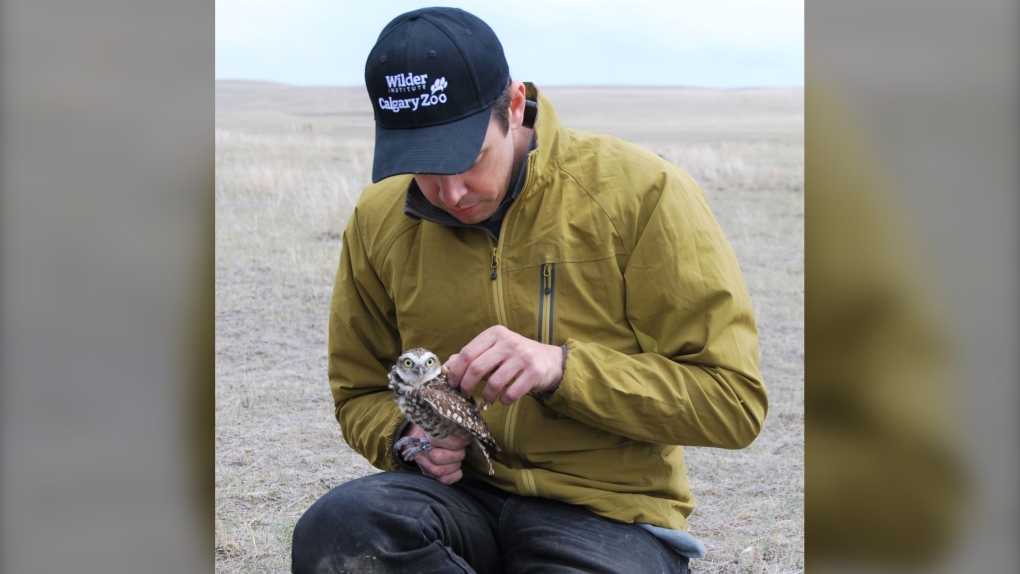Endangered owls, cared for at the Calgary Zoo, now returned to the wild
 Workers with the Wilder Institute/Calgary Zoo will be monitoring the lives of 20 burrowing owls in the wild over the next while to make sure they thrive. (Supplied)
Workers with the Wilder Institute/Calgary Zoo will be monitoring the lives of 20 burrowing owls in the wild over the next while to make sure they thrive. (Supplied)
Zookeepers, who cared for a group of endangered owlets, hope to see the birds mating and laying eggs this season to help bolster Alberta's wildlife population.
Over the past year, staff at the Wilder Institute/Calgary Zoo worked at the facility's Wildlife Conservation Centre (WCC) to raise 20 burrowing owls to give them a head start on a life in the wild.
Without the threat of predators, extreme weather, competition for food and resources, the owls rate of survival has greatly increased, officials say.
"Conservation head-starting is just one piece of a very challenging puzzle," said Graham Dixon-MacCallum, conservation research population ecologist with the Wilder Institute/Calgary Zoo, in a release.
"We know that burrowing owls still face threats in their grasslands habitat, but thanks to this important collaborative effort there are more owls in the wild to regain a foothold in the province."
Staff members that worked with the owlets say they were "lucky" to be a part of their lives.
"It's fantastic to see the progress they have made here at the WCC," said Colleen Baird, senior manager of animal care with the Animal Care, Health, & Welfare team at the Wilder Institute/Calgary Zoo.
"We want to make sure that the owls are equipped to overcome challenges in the wild. Our team of veterinary, animal care, and conservation research experts work together to ensure the owls are healthy and have excellent body condition."
The Prairies are where Canada's burrowing owl population makes their home and habitat loss, climate change and other environmental changes have led to their decline.
"Canada's burrowing owls have seen a more than 90 per cent decline in their population over the last 40 years and are still facing significant threats. One of the many factors that limit their population from growing is the low survival rate of owlets hatched in the wild," the zoo said.
Now that they are free in the Canadian grasslands, the owls are able to nest in secure burrows installed by team members and equipped with a netted enclosure.
They will also be provided food at the location until they lay eggs of their own.
CTVNews.ca Top Stories

Trump making 'joke' about Canada becoming 51st state is 'reassuring': Ambassador Hillman
Canada’s ambassador to the U.S. insists it’s a good sign U.S. president-elect Donald Trump feels 'comfortable' joking with Canadian officials, including Prime Minister Justin Trudeau.
Mexico president says Canada has a 'very serious' fentanyl problem
Foreign Affairs Minister Mélanie Joly is not escalating a war of words with Mexico, after the Mexican president criticized Canada's culture and its framing of border issues.
Quebec doctors who refuse to stay in public system for 5 years face $200K fine per day
Quebec's health minister has tabled a bill that would force new doctors trained in the province to spend the first five years of their careers working in Quebec's public health network.
Freeland says it was 'right choice' for her not to attend Mar-a-Lago dinner with Trump
Deputy Prime Minister and Finance Minister Chrystia Freeland says it was 'the right choice' for her not to attend the surprise dinner with Prime Minister Justin Trudeau at Mar-a-Lago with U.S. president-elect Donald Trump on Friday night.
'Sleeping with the enemy': Mistrial in B.C. sex assault case over Crown dating paralegal
The B.C. Supreme Court has ordered a new trial for a man convicted of sexual assault after he learned his defence lawyer's paralegal was dating the Crown prosecutor during his trial.
Bad blood? Taylor Swift ticket dispute settled by B.C. tribunal
A B.C. woman and her daughter will be attending one of Taylor Swift's Eras Tour shows in Vancouver – but only after a tribunal intervened and settled a dispute among friends over tickets.
Eminem's mother Debbie Nelson, whose rocky relationship fuelled the rapper's lyrics, dies at age 69
Debbie Nelson, the mother of rapper Eminem whose rocky relationship with her son was known widely through his hit song lyrics, has died. She was 69.
NDP won't support Conservative non-confidence motion that quotes Singh
NDP Leader Jagmeet Singh says he won't play Conservative Leader Pierre Poilievre's games by voting to bring down the government on an upcoming non-confidence motion.
Canadians warned to use caution in South Korea after martial law declared then lifted
Global Affairs Canada is warning Canadians in South Korea to avoid demonstrations and exercise caution after the country's president imposed an hours-long period of martial law.

































